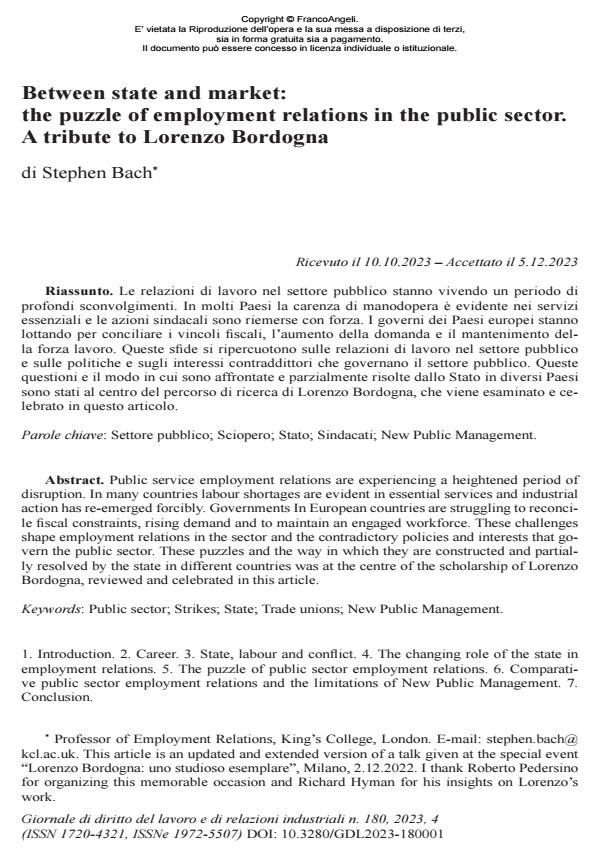Between state and market: the puzzle of employment relations in the public sector. A tribute to Lorenzo Bordogna
Titolo Rivista GIORNALE DI DIRITTO DEL LAVORO E DI RELAZIONI INDUSTRIALI
Autori/Curatori Stephen Bach
Anno di pubblicazione 2024 Fascicolo 2023/180
Lingua Inglese Numero pagine 12 P. 513-524 Dimensione file 634 KB
DOI 10.3280/GDL2023-180001
Il DOI è il codice a barre della proprietà intellettuale: per saperne di più
clicca qui
Qui sotto puoi vedere in anteprima la prima pagina di questo articolo.
Se questo articolo ti interessa, lo puoi acquistare (e scaricare in formato pdf) seguendo le facili indicazioni per acquistare il download credit. Acquista Download Credits per scaricare questo Articolo in formato PDF

FrancoAngeli è membro della Publishers International Linking Association, Inc (PILA)associazione indipendente e non profit per facilitare (attraverso i servizi tecnologici implementati da CrossRef.org) l’accesso degli studiosi ai contenuti digitali nelle pubblicazioni professionali e scientifiche
Public service employment relations are experiencing a heightened period of disruption. In many countries labour shortages are evident in essential services and industrial action has re-emerged forcibly. Governments In European countries are struggling to reconcile fiscal constraints, rising demand and to maintain an engaged workforce. These challenges shape employment relations in the sector and the contradictory policies and interests that govern the public sector. These puzzles and the way in which they are constructed and partially resolved by the state in different countries was at the centre of the scholarship of Lorenzo Bordogna, reviewed and celebrated in this article.
Le relazioni di lavoro nel settore pubblico stanno vivendo un periodo di profondi sconvolgimenti. In molti Paesi la carenza di manodopera è evidente nei servizi essenziali e le azioni sindacali sono riemerse con forza. I governi dei Paesi europei stanno lottando per conciliare i vincoli fiscali, l’aumento della domanda e il mantenimento della forza lavoro. Queste sfide si ripercuotono sulle relazioni di lavoro nel settore pubblico e sulle politiche e sugli interessi contraddittori che governano il settore pubblico. Queste questioni e il modo in cui sono affrontate e parzialmente risolte dallo Stato in diversi Paesi sono stati al centro del percorso di ricerca di Lorenzo Bordogna, che viene esaminato e celebrato in questo articolo.
Parole chiave:Parole chiave: Settore pubblico; Sciopero; Stato; Sindacati; New Public Management
Stephen Bach, Between state and market: the puzzle of employment relations in the public sector. A tribute to Lorenzo Bordogna in "GIORNALE DI DIRITTO DEL LAVORO E DI RELAZIONI INDUSTRIALI " 180/2023, pp 513-524, DOI: 10.3280/GDL2023-180001